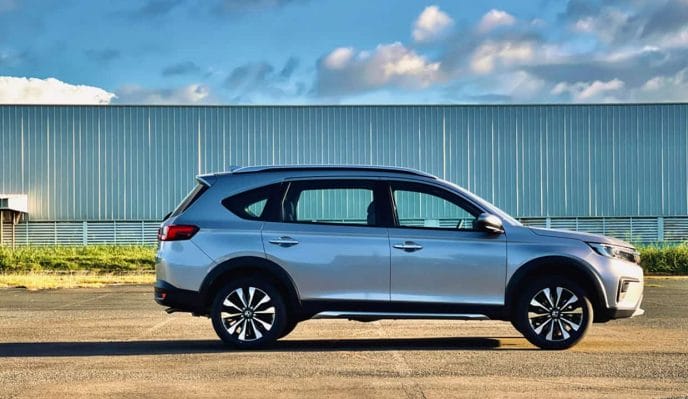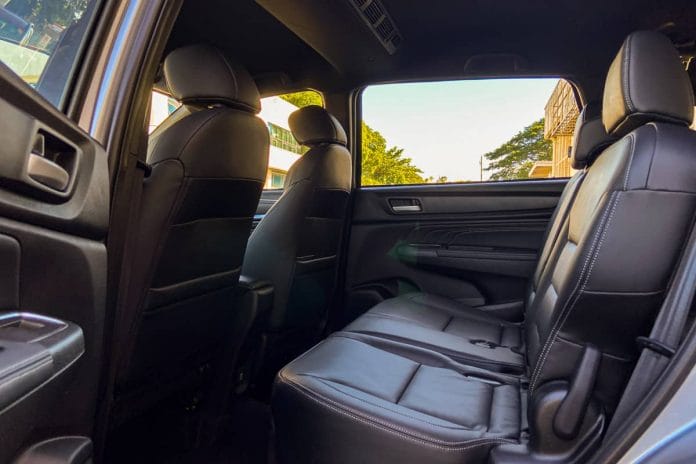I bet we can all agree that 2022 is the year of MPVs. The entire MPV segment has been updated in the Philippines; the latest of which is the Honda BR-V.
A new-generation model that aims to capture the hearts of those looking to buy a family vehicle, the new BR-V builds upon the success of its predecessor while getting modern touches. We got the chance to drive one before its launch and at this point, what I can say is that the BR-V is no longer my least favorite Honda in the lineup.
However, that isn’t without any fault or a point for improvement. Read along.
Exterior
If the previous-generation BR-V looked like a Mobilio on stilts and with unnecessary claddings, the new version looks like a full-blown SUV. Sure there are still claddings but they are tastefully done now unlike before. Also, gone were the nose-down hood and quirky proportions; the second-generation BR-V looks quite nice at any angle, sporting that boxy look with a touch of minimalism.

Much more so with the host of LEDs up front and at the back. If the taillights look familiar, that’s because it’s almost identical to the double underline design found on the City Hatchback. I love the fact that the 17-inch alloy wheels aren’t limited to the top-spec variant anymore; it’s standard across the range, save for the S MT.
Interior & Tech
If you know your Hondas, the new BR-V interior would be familiar, and that isn’t a bad thing. There’s a touch of CR-V on the top of the dashboard, while the steering wheel and instrument panel are reminiscent of the City. Meanwhile, the 7-inch touchscreen with Apple CarPlay/Android Auto and two USB ports are standard across the range.

The driver’s seat is quite comfortable, especially with the height adjuster (also standard across the range). We got to check out all variants during the shoot and what I can say is that whether you’re going for leather or high-grade fabric, the build quality inside is above average. Plus, Honda has moved the seat belt hump forward on the roof, which frees up a bit of headroom for the third-row, right-side occupant.
For tech, remote engine start and walk-away auto lock are standard on higher variants, but speed-sending door locks are available on all trim levels. This is pretty important, but I just wish the variants other than the VX get a normal cruise control feature.


Safety
The Honda BR-V is pretty loaded with safety features even if you’re going for the top-spec variant with Honda Sensing.
All seat belts are three-point, while dual SRS and side airbags are standard – as are the reverse camera with guidelines, Anti-lock Brake System (ABS), Electronic Brake-force Distribution (EBD), Vehicle Stability Assist (VSA), Hill Start Assist (HSA), Security Alarm, Immobilizer, Emergency Stop Signal, and ISO Fix Child Seat Anchor. For the BR-V S with a manual gearbox, that HSA feature should be heaven-sent.
Going for the top-spec VX Honda Sensing loads this up even more with Auto High Beam (AHB), Collision Mitigation Braking System (CMBS), Lane Keep Assist System (LKAS), Road Departure Mitigation (RDM), Lane Departure Warning (LDW), and of course, my favorite, Adaptive Cruise Control (ACC). I have yet to test the ACC but if the other model’s any indication, this should work perfectly well, making highway runs convenient and safe.
Drive & Handling
The new Honda BR-V doesn’t feel huge at all. I love how it behaves on the road like my daily driver, a Brio. It’s easy to maneuver around despite being a relatively huge vehicle.
Powering the BR-V is a revamped naturally aspirated 1.5-liter gasoline engine. Now using DOHC rather than the outgoing SOHC engine, this mill should theoretically have improved power delivery and fuel efficiency. It’s the same found in the City and City Hatchback, which makes 119hp and 145Nm of torque, sent to the wheels via a CVT.
On the actual drive, I felt the improvement. The BR-V behaved better than before but I must say, power delivery is still a bit restrained even on flat surfaces. Maybe it’s the weight but during the test, there were only four people aboard including myself. Then again, you shouldn’t expect a sporty drive with the BR-V – it’s a family vehicle through and through. Even better, the suspension works quite well in keeping bumps at bay, though a more extensive test is needed for a deeper assessment.
I also tested the BR-V on a steep incline found in Honda Cars Philippines, Inc. (HCPI)’s test facility, With seven adults aboard, the BR-V was able to pull up nicely though it was a crawl. Of note, the uphill test was done from a standstill; when there’s momentum involved, it wasn’t bad at all.
Initial Verdict
Like I said earlier, the BR-V is no longer my least favorite Honda in the lineup. It now looks better (way better, actually), while offering way better amenities and features compared to the outgoing model.
Then there’s the question of price. The base S MT BR-V sells for P1,090,000, while the S CVT has a sticker price of P1,150,000. The mid V variant can be had for P1,295,000, while the top-spec VX Honda Sensing has a selling price of P1,390,000.
With the VX Honda Sensing almost crossing the P1.4 million mark, one might say that the new BR-V is overpriced. But consider this – at the price tag, it already comes with advanced safety features that are otherwise available on pricier seven-seaters. And, if you’ll go for the MT variant, it’s great to know that isn’t bare bones unlike other vehicles equipped with stick shifts.
Sure, the new Honda BR-V isn’t a bargain but considering the features and overall improvements employed – and accounting for inflation – you know you’re getting your money’s worth.

